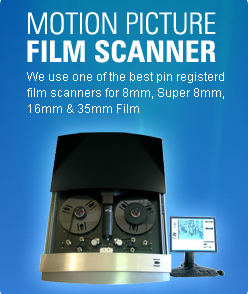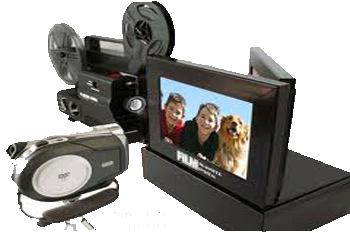
Film Conversion Equipment
Film Scanning and Film Transfer Equipment Types
The type of film scanning machine used for your 8mm, Super 8 or 16mm film conversion will have as much of an impact on the quality you receive as the resolution of the scan itself will. For example, if you wanted to digitize a photograph and tried doing it two different ways. You first put the photograph down on a table and took a picture of it using your smart phone or camera. Then you took the picture and scanned it using a flatbed scanner. If you compare the two side by side on your computer it will become really obvious that the flatbed scanner produced a digital image as good as the photograph. However, the picture you took with your phone or camera does not look close to the quality of the original photograph.
The same goes for scanning your 8mm, Super 8 or 16mm film. The real-time and frame by frame machines below are using a camcorder to take a picture of your film. The motion picture film scanner and Datacine machine are scanning the film. The results will be significantly different.
Film Conversion Equipment |
|
Real Time
|
|
Frame by Frame
|
|
Professional Film Scanners
|
|
Equally important as resolution is the type of film transfer. There are a few basic types of film transfer processes. More than 80% of the companies out there today use a real-time transfer. Any type of real-time film transfer will result in video that is 40-50% worse than the film’s current condition.
So, at this point you’ve learned that film transfers can capture at standard definition (480 lines), high definition (1080 lines) or 2K (1556 lines). You’ve also learned about the 3 different types of film transfers being used today. In order from least to best quality we have:
The film transfer processes above are the basics types and do not include any restoration by themselves. Restoration comes in many different capabilities from color and exposure correction, to grain elimination, to stabilization
Memphis Fun Facts: Known as the birthplace of the Blues and home of Elvis Presley, Memphis is one of America's top cities for tourism. Memphis, located on the Mississippi River in the southwest corner of Tennessee, is the largest city in the state. Settled by Native Americans and later the French, Memphis was founded in 1819 and incorporated in 1826. After falling to Union forces during the Civil War, then suffering yellow fever epidemics in the 1870s, the city declined and went bankrupt.
Tennessee Fun Facts: Tennessee’s two largest cities, Memphis and Nashville, are known as centers of blues and country music, respectively,and have played host tothe likes ofElvis Presley, Jerry Lee Lewis, Muddy Waters, Johnny Cash, B.B. King and Dolly Parton. Memphis is also famous for its barbecue and hosts the well-attended “Memphis in May” barbecue competition each year. Tennessee became the 16th state of the union in 1796.








